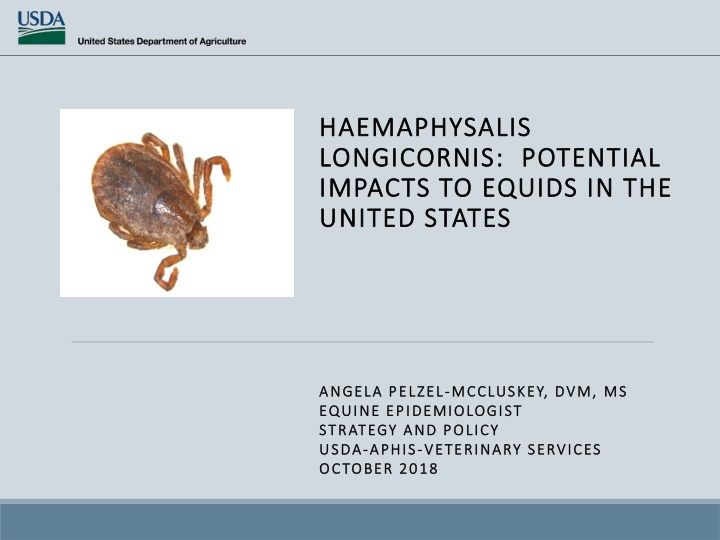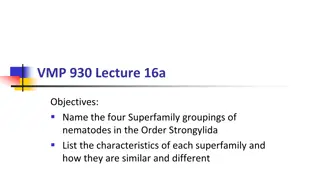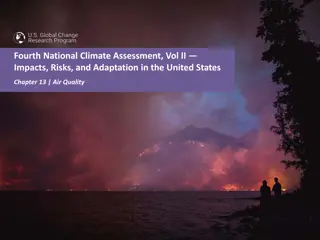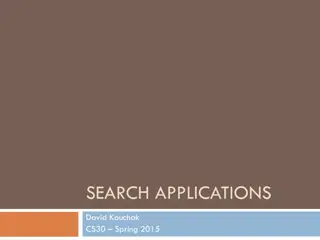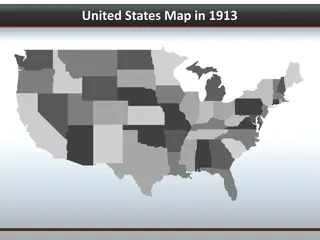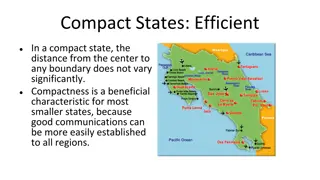Potential Impacts of Haemaphysalis longicornis on Equids in the United States
Haemaphysalis longicornis, an Asian longhorned tick, poses potential threats to equids in the United States. Originally from Northeast Asia, this tick has been detected in the U.S. and has a wide range of hosts, including cattle, sheep, dogs, humans, and various wildlife. Its parthenogenic reproductive ability can lead to explosive population growth, and it has been found infesting different species in several states. Collection records at NVSL indicate past instances of this tick being imported into the country. Vigilance and control measures are crucial to prevent the spread of this tick and safeguard equine health.
Download Presentation

Please find below an Image/Link to download the presentation.
The content on the website is provided AS IS for your information and personal use only. It may not be sold, licensed, or shared on other websites without obtaining consent from the author.If you encounter any issues during the download, it is possible that the publisher has removed the file from their server.
You are allowed to download the files provided on this website for personal or commercial use, subject to the condition that they are used lawfully. All files are the property of their respective owners.
The content on the website is provided AS IS for your information and personal use only. It may not be sold, licensed, or shared on other websites without obtaining consent from the author.
E N D
Presentation Transcript
HAEMAPHYSALIS HAEMAPHYSALIS LONGICORNIS LONGICORNIS: POTENTIAL IMPACTS TO IMPACTS TO EQUIDS EQUIDS IN THE UNITED STATES UNITED STATES : POTENTIAL IN THE ANGELA PELZEL ANGELA PELZEL- -MCCLUSKEY, DVM, MCCLUSKEY, DVM, MS EQUINE EPIDEMIOLOGIST EQUINE EPIDEMIOLOGIST STRATEGY AND POLICY STRATEGY AND POLICY USDA USDA- -APHIS APHIS- -VETERINARY SERVICES VETERINARY SERVICES OCTOBER 2018 OCTOBER 2018 MS
Index Finding: Aug-Nov 2017 Hunterdon County, NJ August 2017: sheep owner in NJ presents ticks to the county entomologist Late October/Early November: sheep examined; heavy infestation with unusual ticks Molecular ID by Rutgers then confirmed by NVSL to be Haemaphysalis longicornis First detection in the U.S. outside of import quarantine
Haemaphysalis Haemaphysalislongicornis longicornis Asian longhorned tick 3 host hard tick exotic to the U.S. Originally from North East Asia then expanded into Australia, New Zealand, Pacific Rim countries Prefers meadow areas where rain>5 cm/month Survives harsh winters Parthenogenic: female can reproduce in the absence of a male Creates explosive mini populations
Hosts Primarily Cattle But also: sheep, dogs, humans, yak, donkeys, hedgehogs, horses, pigs, ducks, turkeys, chickens, mynas, magpies, pheasants, budgerigar, thrush, skylark, kiwis, banded rails, sparrows, rabbits, goats, badgers, cats, deer, bears, foxes, raccoons, kangaroos, chipmunks, rats, mice, ferrets, stoats, weasels, brushtail opossums, wallaroos, wallabies, bandicoots, etc. Additional US: coyotes, groundhogs, grey fox Zheng et al 2011
H. longicornis Collection at NVSL NVSL collection contains a dozen previous examples collected from 1969- 2011 from imported animals Usually horses presented for entry from New Zealand or Australia 5
State Species Found Infested Date of Earliest Finding Arkansas Dog May 2018 Connecticut Environment July 2018 New Jersey Sheep, goat, horse, dog, deer, raccoon, opossum, groundhog Dog - 2013 New York Human, environment Human June 2018 Maryland Deer July 2018 North Carolina Opossum, human, dog Opossum - 2017 Pennsylvania Deer, human, environment Deer July 2018 Virginia Cattle, horse, deer, goat, dog, environment CO2 trap March 2017 West Virginia Cattle, dogs, deer, cat, coyote, environment Deer August 2010 7
Known pathogens: Anaplasma phagocytophilum Powassan virus Anaplasma bovis Khasan virus Borrelia spp. Tick-borne encephalitis virus Babesia ovata Russian Spring-Summer Encephalitis Virus Babesia major Severe Fever with Thrombocytopenia syndrome Babesia gibsoni Huaiyangshan virus hemorrhagic fever Babesia bigemina and bovis Thogotoviruses (Thogoto virus, Bourbon virus) Ehrlichia chafeensis Rickettsia japonica Theileria equi Theileria orientalis
Testing of H. longicornis collected from NJ: RT-PCR negative at the CDC: Powassan, Bourbon, and Heartland virus 120 tick samples negative for: Borrelia burgdorferi Borrelia miyamotoi Anaplasma phagocytophilum Babesia microti Ehrlichia chafeensis Ehrlichia ewingii NJ infested sheep tested negative for: Babesia bigemina Babesia bovis Theileria spp. Rickettsia Anaplasma marginale Ehrlichia ruminatium Coxiella burnetii SFTS virus (Severe Fever with Thrombocytopenia Syndrome, a human disease). 9
Virginia: Beef cattle premises with Theileria orientalis December 2017: FAD investigation conducted on Albemarle County, VA beef herd. Clinical signs consistent with anemia. Mortality 7/120 animals NVSL confirmed Theileria orientalis in six animals within the herd. March 2018: Ticks collected from orphaned calf on the farm. NVSL confirmed H. longicornis. H. longicornis is a known competent vector for T. orientalis in New Zealand and Australia 10
Potential impacts to equids Stress, reduced growth and production, anemia, weight loss, severe blood loss Competent vector for: Theileria equi Anaplasma phagocytophilum Borrelia burgdorferi Powassan virus 2018 China: report of H. longicornis harboring Francisella tularensis Unknown competency for new and emerging diseases Encourage submission of ticks found on clinically ill horses (fever, anemia, neurologic, non-specific illness cases) 11
Horses as Pathways of Entry for Exotic Pests History of H. longicornis isolations from horses in import quarantine World Equestrian Games 2018 Hippobosca equina (horse louse fly) from France Collected from a group of imported horses at the Tryon International Equestrian Center Found only in the Eastern hemisphere Not a known vector of any disease agents Irritating bite. Observed moving between horses at the facility. Hyalomma marginatum ticks from Portugal Collected from 2 different imported horses at the Tryon International Equestrian Center Found in the Eastern hemisphere and Mediterranean Basin Known vector for B. caballi, T. equi, Crimean-Congo hemorrhagic fever, several other viruses and Rickettsia transmissible to humans Collected only twice previously 1966 imported horses from Spain, 1981 shipment of cork from Europe Both host horses piroplasmosis positive; entered the event on a piro waiver 12
Acknowledgements Denise Bonilla, APHIS-VS SCWDS USDA APHIS VS SPRS Rutgers USDA APHIS Wildlife Services CDC USDA ARS NJ Public Health USDA APHIS VS CEAH and NVSL Monmouth Co Vector Control Hunterdon Co, NJ Departments of Agriculture in all affected States NJ State Mosquito Control NJ Dept of Environment VA Tech NY State Dept of Health 13
Angela Pelzel-McCluskey, DVM, MS Equine Epidemiologist Sheep, Goat, Cervid, and Equine Health Center Strategy and Policy USDA-APHIS-Veterinary Services Angela.M.Pelzel@aphis.usda.gov 970-494-7391 14
